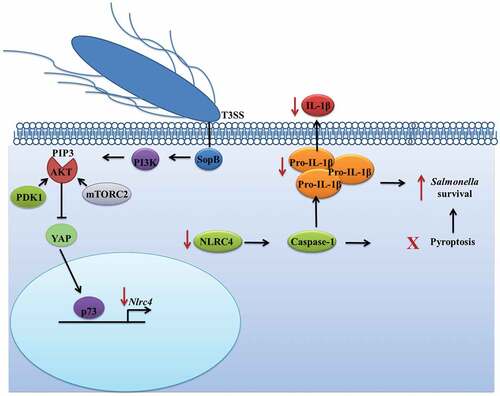Figures & data
Figure 1. Salmonella effector SopB promotes Akt activation and YAP phosphorylation in B cells. (a) Western blot analysis of pAkt S473, pAkt T308, pYAP S127 and the corresponding total protein levels in B cells from BALB/c mice infected with Salmonella Typhimurium wild-type, Salmonella Typhimurium ΔsopB, Salmonella Typhimurium ΔsopB-pSopB or Salmonella Typhimurium ΔsopB-pSopB C460S at an MOI of 50. (b) Protein levels of pAkt S473, pAkt T308 and pYAP relative to total Akt or total YAP levels were normalized to the control (not infected). (c) Western blot analysis of pAkt S473, pAkt T308, pYAP S127 and the corresponding total protein levels in B cells from BALB/c mice pretreated for 30 minutes with the Akt inhibitor AKT VIII (2,12 µM) or the PDK1 inhibitor GSK23334470 (50 µM) and infected with Salmonella Typhimurium wild-type at an MOI of 50. Inhibitors were present before, during and after infection. (d) Protein levels of pAkt S473, pAkt T308 and pYAP S127 relative to total Akt and total YAP levels were normalized to the control (not infected). (e) Western blot analysis of pAkt S473 and pYAP S127 and the corresponding total protein levels in B cells from Rictorfl/fl and Cd19Cre/Rictorfl/fl mice infected with Salmonella Typhimurium wild-type at an MOI of 50. (f) Protein levels of pAkt S473 and pYAP S127 relative to total Akt and total YAP levels were normalized to the control (not infected). Data are representative Western blotting images or are expressed as the mean ± S.D. of at least three different experiments. Data were analyzed by Student’s t-test. *p < 0.05, **p < 0.01, ***p < 0.001.
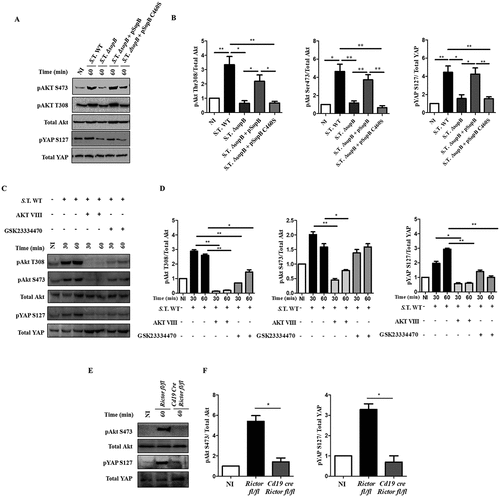
Figure 2. Activation of Akt by Salmonella in B cells follows a canonical PI3K activation mechanism. (a) Western blot analysis of pAkt S473, pAkt T308 and total Akt in B cells from BALB/c mice pretreated for 60 minutes with the PI3K inhibitor wortmannin at a concentration of 0,2 µM or 1 µM and infected with Salmonella Typhimurium wild-type at an MOI of 50. (b) Protein levels of pAkt T308 and pAkt S473 relative to total Akt levels were normalized to the control (not infected). (c) Western blot analysis of p-p85 Y458 and total p85 in B cells from BALB/c mice infected with Salmonella Typhimurium wild-type at an MOI of 50. (d) Protein levels of p-p85 Y458 relative to total p85 levels were normalized to the control (not infected). (e) Representative confocal immunostaining of PIP3 in B cells from BALB/c mice infected with Salmonella Typhimurium wild-type-GFP at an MOI of 50. Data are representative Western blotting images or are expressed as the mean ± S.D. of three different experiments. Data were analyzed by Student’s t-test. *p < 0.05, **p < 0.01, ***p < 0.001. Scale bar, 5 µm.
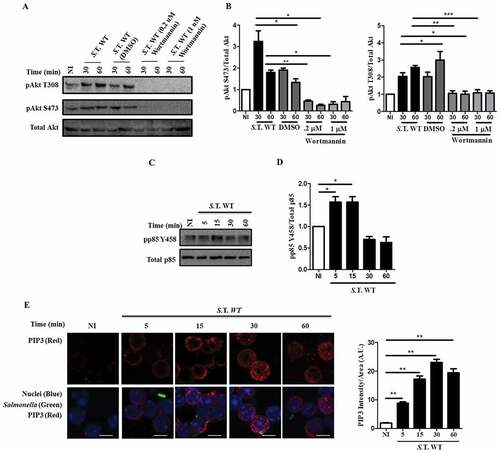
Figure 3. Salmonella promotes Akt-YAP pathway activation to block IL-1β secretion. (a) IL-1β secretion levels in supernatants of B cells from BALB/c mice infected with Salmonella Typhimurium wild-type or ΔsopB at an MOI of 50. (b) IL-1β secretion levels in supernatants of B cells from BALB/c mice pretreated for 60 minutes with the PI3K inhibitor wortmannin (0.2 µM) or for 30 minutes with the Akt inhibitor AKT VIII (2,12 µM) or the PDK1 inhibitor GSK23334470 (50 µM) and infected with Salmonella Typhimurium wild-type at an MOI of 50. Inhibitors were present before, during and after infection. Viability of infected-B cell not treated with inhibitors was similar to infected-B cell treated with inhibitors (data not shown) (c) IL-1β secretion levels in supernatants of B cells from Rictorfl/fl and Cd19Cre/Rictorfl/fl mice infected with Salmonella Typhimurium wild-type at an MOI of 50. Data are expressed as the mean ± S.D. of three different experiments. Data were analyzed by Student’s t-test. *p < 0.05, **p < 0.01, ***p < 0.001.
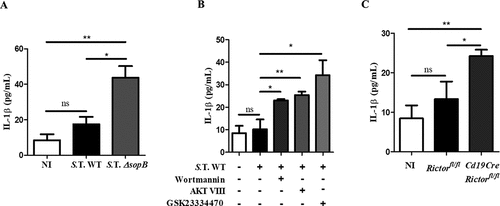
Figure 4. Salmonella activates the Akt-YAP pathway through SopB to survive in B cells. (a) Bacteria kinetic survival in B cells from BALB/c mice infected with Salmonella Typhimurium wild-type or Salmonella Typhimurium ΔsopB at an MOI of 50. (b) Survival percentage was calculated using the following formula (CFUs 24 h PI/CFUs 1 h PI). (c) Bacteria kinetic survival in B cells from BALB/c mice pretreated for 60 minutes with the PI3K inhibitor wortmannin (0.2 µM) or for 30 minutes with the Akt inhibitor AKT VIII (2,12 µM) or the PDK1 inhibitor GSK23334470 (50 µM) and infected with Salmonella Typhimurium wild-type at an MOI of 50. Inhibitors were present before, during and after infection. Viability of infected-B cell not treated with inhibitors was similar to infected-B cell treated with inhibitors (data not shown) (d) Survival percentage was calculated using the following formula: (CFUs 24 h PI/CFUs 1 h PI). (e) Bacteria kinetic survival in B cells from Rictorfl/fl and Cd19Cre/Rictorfl/fl mice infected with Salmonella Typhimurium wild-type at an MOI of 50. (F) Survival percentage was calculated using the following formula: (CFUs 24 h PI/CFUs 1 h PI). Data are expressed as the mean ± S.D. of at least three different experiments. Survival percentage data were analyzed by Student’s t-test. Survival kinetic data were analyzed by two-way ANOVA with a post hoc Bonferroni test. *p < 0.05, **p < 0.01, ***p < 0.001.
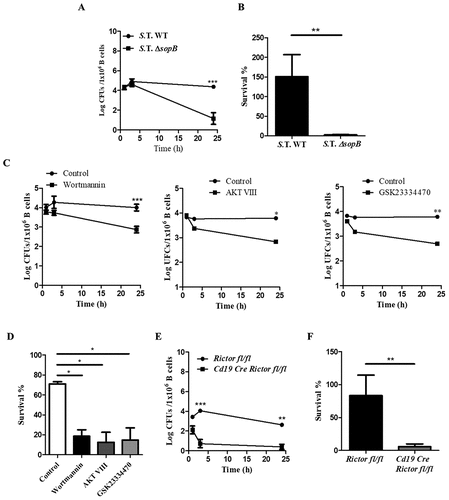
Figure 5. Salmonella SopB activates the Akt-YAP pathway in B cells infected in vivo. (A) Flow cytometric analysis of pAkt S473, pAkt T308 and pYAP S127 in B cells from BALB/c mice infected intraperitoneally with 50 CFUs of Salmonella Typhimurium wild-type-GFP or Salmonella Typhimurium ∆sopB-GFP. (B) Mean fluorescence intensity of pAkt S473, pAkt T308 and pYAP S127. Data are expressed as the mean ± S.D. of three different experiments. Data were analyzed by Student’s t-test. *p < 0.05, **p < 0.01, ***p < 0.001.
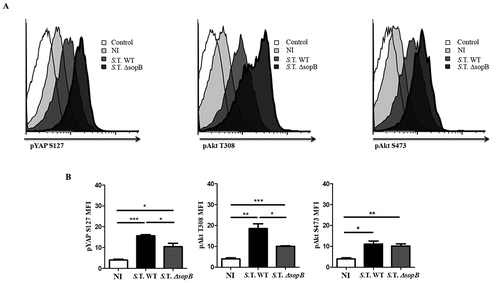
Figure 6. Salmonella effector SopB activates the Akt-YAP pathway to prevent IL-1β secretion. Through PI3K, SopB promotes the production of PIP3, which recruits Akt. Next, PDK1 and mTORC2 phosphorylate Akt (at threonine 308 and serine 473, respectively) to activate it. Once active, Akt phosphorylates the coactivator YAP at serine 127, leading to YAP sequestration in the cytoplasm and preventing it from heterodimerizing with the transcription factor p73. Without the p73-YAP heterodimer, the transcription of Nlrc4 is reduced, which impacts the processing and secretion of the pro-inflammatory cytokine IL-1β and leads to the survival of Salmonella in B cells.
